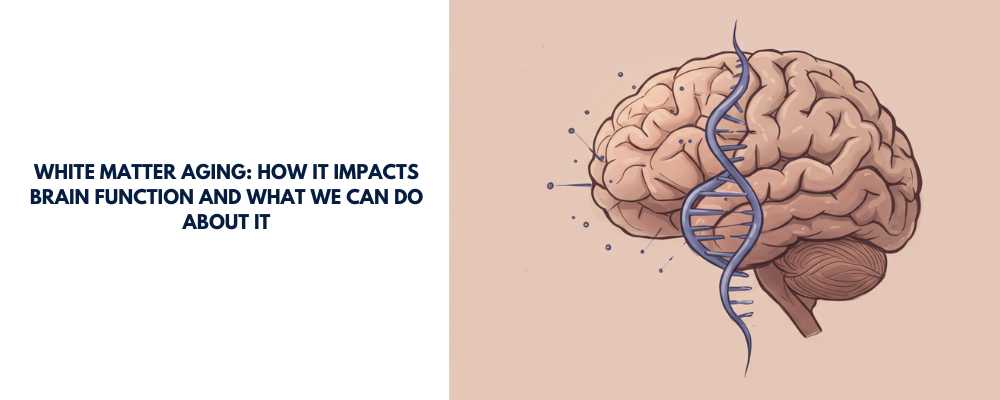White Matter Aging: How it Impacts Brain Function and What We Can Do About It

As we age, our bodies undergo many changes, and the brain is no exception. While much attention is given to the brain's grey matter, the white matter, which comprises about 40% of the human brain, also experiences significant alterations with age. These changes in white matter can impact cognitive functions and increase the risk of neurological diseases. This blog post will explore the structural and functional changes in white matter that occur with aging, discuss the underlying mechanisms driving these transformations, and highlight potential strategies to mitigate these changes, drawing on Groh and Simons (2024).
What is White Matter and Why Does it Matter?
White matter consists primarily of myelinated axons, glial cells, blood vessels, and the extracellular matrix. Oligodendrocytes, the main cells in white matter, produce myelin sheaths that are crucial for fast signal transmission and for maintaining the functional and structural integrity of axons. White matter connects different grey matter areas, enabling efficient communication between brain regions.
How Does White Matter Change With Age?
* Volume Reduction: White matter volume increases rapidly during early childhood, peaks around age 30, and then begins to decline after age 50. This decline is accompanied by an exponential increase in ventricular volume.
* Microstructural Integrity Decline: Studies using diffusion tensor imaging show that water diffusivity generally changes with age, indicating deterioration in white matter composition and integrity.
* White Matter Hyperintensities (WMHs): These appear as increased signal intensity on T2-weighted MRI scans and are commonly associated with normal aging. They often indicate pathological changes in the white matter, potentially resulting from chronic ischemic small vessel disease, hypertension, diabetes mellitus, and other vascular risk factors.
* Myelin Alterations: Early light microscopy studies have shown reduced staining intensity in the aged human cortex, especially in areas and fiber tracts that myelinate later in life. Electron microscopy analyses have detected degenerative changes in myelin, such as splitting of the major dense line and formation of blebs. Older adults may have approximately 15% less white matter and 25% shorter total length of myelinated fibers compared to younger individuals.
What are the Cellular and Molecular Mechanisms Behind White Matter Aging?
* Oxidative Damage: Oxidative damage from reactive oxygen species (ROS) is a hallmark of aging and can alter protein structure and function. ROS-induced lipid peroxidation can damage membranes and produce reactive by-products that further harm cells.
* Oligodendrocyte Dysfunction: As oligodendrocytes age, they transition into a disease-associated state, upregulating immune-related genes and downregulating cholesterol biosynthesis pathways.
* Impaired Remyelination: Aging is a key factor contributing to remyelination failure. The slowing of remyelination with aging is marked by the impaired recruitment of OPCs to the lesion area and their reduced differentiation into oligodendrocytes. Chronically demyelinated lesions either have few OPCs or contain OPCs that have not successfully differentiated.
* Inflammation: Aging leads to a more inflammatory microenvironment in the brain, compromising neuroaxonal integrity. Microglia become primed with aging, leading to an enhanced expression of their pro-inflammatory machinery. Astrocytes also show regional differences in their vulnerability to aging, with more pronounced reactive states in myelin-rich brain regions.
* Adaptive Immune Reactions: White matter aging is associated with changes in the adaptive immune system, particularly through the increased presence of T cells. In the aging brain, CD8+ TRM cells accumulate predominantly in white matter tracts, where they closely interact with myelinated axons that show signs of damage.
How Does White Matter Aging Impact Disease?
The susceptibility of white matter to aging has implications for diseases where age is a risk factor. These diseases, which encompass neurodegenerative, vascular, and neuroinflammatory disorders, typically share a prolonged preclinical phase and a tendency for accelerated progression with advanced age.
* Alzheimer's Disease (AD): Myelin dysfunction reduces the number of plaque-associated microglia, and oligodendrocytes have recently been shown to contribute to Ab production and synaptic dysfunction in models of AD.
* Small Vessel Disease: Aging is a major risk factor for small vessel disease, which accounts for about 20% of all dementia cases and is the second most common cause of chronic progressive cognitive impairment.
* Multiple Sclerosis (MS):
* Disease Progression: MS is typically diagnosed at a young age as a relapsing-remitting disease, but after several decades, approximately two-thirds of patients subsequently develop secondary progressive MS. This suggests that normal brain aging may contribute to the worsening of the disease.
* Remyelination Failure: Aging-related white matter changes can speed up pathology in MS. As individuals age, the ability of OPCs to differentiate into myelin-forming oligodendrocytes diminishes. White matter aging modifies the microenvironment, hindering oligodendrocytes from effectively engaging in the regenerative process.
* Role of Myeloid Cells: Experiments have demonstrated that monocyte-derived macrophages from young mice can effectively restore remyelination in aged mice with demyelinating white matter injury, underscoring the significant impact of age on phagocytes. Microglia become more reactive with age and participate in myelin degeneration.
* Microglial Response: Microglia in aging brains exhibit a diminished response to demyelinating injuries. The loss of microglial plasticity results in a failure to activate the necessary transcriptional pathways for clearing myelin debris. Not only is the phagocytosis of myelin debris reduced, but its lysosomal degradation and subsequent metabolism are also impaired.
* Epigenetic Alterations: The reasons behind the microglial unresponsiveness in the aging brain remain unclear but appear to involve epigenetic alterations that can be restored by innate immune training.
* Consequences for Regeneration: The inability of microglia and macrophages to effectively phagocytose, degrade, and metabolize myelin debris has significant consequences for the regenerative process, leading to an increased likelihood of accelerated progression of disease pathology in demyelinating disorders.
What Can We Do About White Matter Aging?
* Improve Myelin Integrity: Rejuvenation studies suggest that restoring oligodendrocyte function may improve myelin integrity.
* Target Inflammation: Selectively inhibiting harmful T cell reactions while fostering regulatory T cell functions could help reduce inflammation and restore the regenerative capacity of the aging brain.
Conclusion
White matter aging is a complex process involving structural, molecular, cellular, and functional alterations. Alterations in oligodendrocytes and myelin perturbation, immunosenescence, and vascular alterations are potential contributors to this process. By understanding the mechanisms driving white matter aging, we can develop strategies to mitigate these changes and reduce the risk of age-related cognitive decline and neurological diseases. The insights gained from studying white matter aging in the context of diseases like multiple sclerosis can provide valuable targets for therapeutic interventions aimed at preserving myelin integrity and function throughout life.
Disclaimer: This blog post is based on the provided research article and is intended for informational purposes only. It is not intended to provide medical advice. Please consult with a healthcare professional for any health concerns.
Reference:
Groh, J., & Simons, M. (2025). White matter aging and its impact on brain function. Neuron, 113(1), 127-139.
